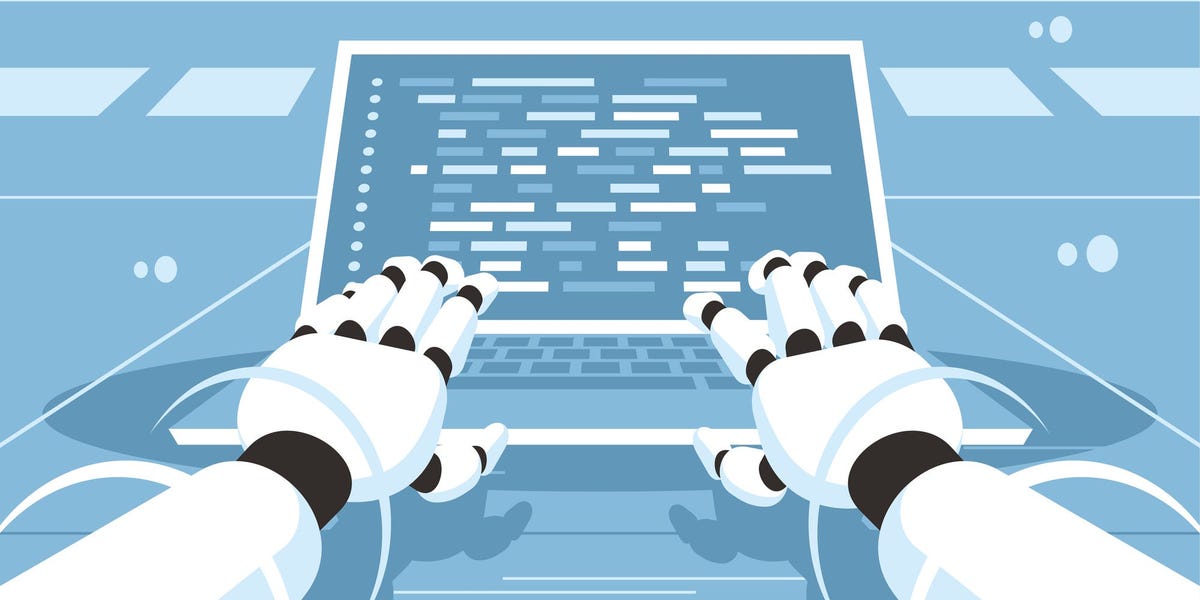The difficult part of software development has always been the continuing support. Did the chatbot setup a versioning system, a build system, a backup system, a ticketing system, unit tests, and help docs for users. Did it get a conflicting request from two different customers and intelligently resolve them? Was it given a vague problem description that it then had to get on a call with the customer to figure out and hunt down what the customer actually wanted before devising/implementing a solution?
This is the expensive part of software development. Hiring an outsourced, low-tier programmer for almost nothing has always been possible, the low-tier programmer being slightly cheaper doesn’t change the game in any meaningful way.
Yeah, I’m already quite content, if I know upfront that our customer’s goal does not violate the laws of physics.
Obviously, there’s also devs who code more run-of-the-mill stuff, like yet another business webpage, but those are still coded anew (and not just copy-pasted), because customers have different and complex requirements. So, even those are still quite a bit more complex than designing just any Gomoku game.
I’m already quite content, if I know upfront that our customer’s goal does not violate the laws of physics.
Haha, this is so true and I don’t even work in IT. For me there’s bonus points if the customer’s initial idea is solvable within Euclidean geometry.
Now I am curious what the most outlandish request or goal has been so far?
Well, as per above, these are extremely complex requirements, so most don’t make for a good story.
One of the simpler examples is that a customer wanted a solution for connecting special hardware devices across the globe, which are normally only connected directly.
Then, when we talked to experts for those devices, we learnt that for security reasons, these devices expect requests to complete within a certain timeframe. No one could tell us what these timeframes usually are, but it certainly sounded like the universe’s speed limit, a.k.a. the speed of light, could get in our way (takes roughly 66 ms to go halfway around the globe).
Eventually, we learned that the customer was actually aware of this problem and was fine with a solution, even if it only worked across short distances. But yeah, we didn’t know that upfront…
While I do agree that management is genuinely important in software dev:
If you can rewrite the codebase quickly enough, versioning matters a lot less. Its the idea of “is it faster to just rewrite this function/package than to debug it?” but at a much larger scale. And while I would be concerned about regressions from full rewrites of the code… have you ever used software? Regressions happen near constantly even with proper version control and testing…
As for testing and documentation: This is actually what AI-enhanced tools are good for today. These are the simple tasks you give to junior staff.
Conflicting requests and iterating on descriptions: Have you ever futzed around with chatgpt? That is what it lives off of. Ask a question, then ask a follow up question, and so forth.
I am still skeptical of having no humans in the loop. But all of this is very plausible even with today’s technology and training sets.
Just to add a bit more to that. I don’t think having an AI operated company is a good idea. Even ignoring the legal aspects of it, there is a lot of value to having a human who can make irrational decisions because one customer will pay more in the long run and so forth.
But I can definitely see entire departments being a node in a rack. Customers talk to humans (or a different LLM) which then talk to the “Network Stack” node and the “UI/UX” node and so forth.
If you just let it do a full rewrite again and again, what protects against breaking changes in the API? Software doesn’t exist in a vacuum, there might be other businesses or people using a certain API and relying on it. A breaking change could be as simple as the same endpoint now being named slightly differently.
So if you now start to mark every API method as “please no breaking changes for this” at what point do you need a full software developer again to take care of the AI?
I’ve also never seen AI modify an existing code base, it’s always new code getting spit out (80% correct or so, it likes to hallucinate functions that don’t even exist). Sure, for run of the mill templates you can use it, but even a developer who told me on here they rely heavily on ChatGPT said they need to verify all the code it spits out, because sometimes it’s garbage.
In the end it’s a damn language model that uses probability on what the next word should be. It’s fantastic for what it does, but it has no consistent internal logic and the way it works it never will.
You are literally describing constraints. They can be applied to an LLM the same way they can be applied to a dev team. And if you have never had to report an API change that breaks functionality… I wish I was you.
And if your full time software engineers are just running a unit test suite all day? … are you hiring?
As for modifcations: Again, have you ever used an LLM? Have a conversation with chatgpt. It will iterate on its responses. That is iterating on code.
In the end it’s a damn language model that uses probability on what the next word should be. It’s fantastic for what it does, but it has no consistent internal logic and the way it works it never will.
And that is demonstrably false and mostly just highlights that you don’t know what you are talking about. Or what language is, for that matter.
Mate, I’ve used ChatGPT before, it straight up hallucinates functions if you want anything more complex than a basic template or a simple program. And as things are in programming, if even one tiny detail is wrong, things straight up don’t work. Also have fun putting ChatGPT answers into a real program you might have to compile, are you going to copy code into hundreds of files?
My example was public APIs, you might have an endpoint
/v2/devicethat was generated the first time around. Now external customers/businesses built their software to access this endpoint. Next run around the AI generates/v2/applianceinstead, everything breaks (while the software itself and unit tests still seem to work for the AI, it just changed a name).If you don’t want that change you now have to tell the AI what to name things (or what to keep consistent), who is going to do that? The CEO? The intern? Who writes the perfect specification?
Yes. ChatGPT is not perfect. Because it is a general purpose LLM. Stuff like Github CoPilot and other software specific approaches are a LOT better at avoiding all the noise from bad answers on stack overflow and proposals. In large part because they have more focused training data.
But it can still do a remarkably good job so long as you have a human looking at it after the fact. Which… is how I would describe most software engineers I have ever worked with. Even the SSEs need someone to review their code. Which… is what is being described here. Combine that with a gitlab runner and you got yourself a stew.
As for APis and the like: Again, it feels like nobody here has ever actually worked with public software and think regressions don’t exist. But this is literally constraints and would be put in the requirements document that you give either the dev team or the LLM.
As for who is going to make that document: The same people who already do? Management.
Management and sound technical specifications, that sounds to me like you’ve never actually worked in a real software company.
You just said what the main problem is: ChatGPT is not perfect. Code that isn’t perfect (compiles + has consistent logic) is worthless. If you need a developer to look over it you’ve already lost and it would be faster to have that developer write the code themselves.
Have you ever gotten a pull request with 10k lines of code? The AI could spit out so much code in an instant, no developer would be able to debug this mess or do a code review. They’ll just click “Approve” and throw it on the giant garbage heap whatever the AI decided to spit out.
If there’s a bug down the line (if you even get the whole thing to run), good luck finding it if no one in your developer team even wrote the code in the first place.
Management and sound technical specifications, that sounds to me like you’ve never actually worked in a real software company.
Worked at quite a few. Once you get out of college and start engaging with companies beyond “Ugh, how dare they want me to waste my precious time by talking to people” you start to learn the value of a strong management team.
And, more importantly, where those jira tickets come from.
A bog standard development flow is “all pull requests are linked to a documented issue/ticket. All pull requests require tests to pass, code coverage to not decrease, and approval by a code owner”
How does that work in reality?
Issues/tickets (just going to say issues from here on out) are created by a combination of customer feedback, identified issues by the development team, and directives from on high (which is generally related to the overall roadmap). One or more developers work on a merge request, the person who best understands the appropriate code looks it over, it is tested, and it is merged in. After enough of those cycles happen, a release is prepared and a manager signs off on it.
How does that map to an “AI” based workflow?
Issues/tickets (just going to say issues from here on out) are created by a combination of customer feedback, identified issues by the development team, and directives from on high (which is generally related to the overall roadmap). Because LLMs can provide feedback and uncertainty measurements once you get past Google Bard. And regression testing and nightly performance testing can highlight deficiencies. The issue is put into a template, that includes all existing constraints, and the LLM generates a solution. Someone who understands the code checks to make sure that looks sane, it is tested, and it is merged in. After enough of those cycles happen, a release is prepared and a manger signs off on it.
And then it becomes a question of what level you start requiring humans. Because when I do a code review prior to a Release? I am relying VERY heavily on my team to have been doing their due diligence. I skim through the MRs and look for a few hot spots but it is mostly “Well, Fred and Nancy said this was good and it passes all the tests so…”
You just said what the main problem is: ChatGPT is not perfect. Code that isn’t perfect (compiles + has consistent logic) is worthless. If you need a developer to look over it you’ve already lost and it would be faster to have that developer write the code themselves.
I VEHEMENTLY disagree with this. If you don’t have developers looking over your code then you are not a software engineer. And if it takes them the same amount of time to review code as it does to write it? You aren’t working on interesting problems and are wasting vast amounts of money.
I can farm out a general task of “improve our code coverage” to an intern. They can spend a few days (or even weeks) doing that, and I can review their MRs in a few minutes. If something looks weird, I leave a comment and wait for them to get back to me. All the time I am working on much more interesting problems… or doing the same for my SSEs.
Once you stop worshiping the ground that “developers” walk on (which mostly comes from time and experience) you start to realize how many people spend most of their lives just filling out tickets with no understanding of “Why”. And how much work your management is putting in so that you don’t throw a temper tantrum or break the code base. Which… maps pretty well to an LLM.
Just to make it clear. I am not saying that all developers should strive to be managers. I actively disagree with that.
But if you aren’t interested in how management works? Whether it is because you want a heads up when crunch is coming or want to understand the big picture or just figure out when it is time to get getting? Then you aren’t growing as a developer and are not an engineer. You are a monkey with a typewriter in the basement.
Which is why plenty of companies merely pay lip service to it, or don’t do it at all and outsource it to ‘communities’
Absolutely true, but many direction into implementing those solution with AIs.
“I gave an LLM a wildly oversimplified version of a complex human task and it did pretty well”
For how long will we be forced to endure different versions of the same article?
The study said 86.66% of the generated software systems were “executed flawlessly.”
Like I said yesterday, in a post celebrating how ChatGPT can do medical questions with less than 80% accuracy, that is trash. A company with absolute shit code still has virtually all of it “execute flawlessly.” Whether or not code executes it not the bar by which we judge it.
Even if it were to hit 100%, which it does not, there’s so much more to making things than this obviously oversimplified simulation of a tech company. Real engineering involves getting people in a room, managing stakeholders, navigating conflicting desires from different stakeholders, getting to know the human beings who need a problem solved, and so on.
LLMs are not capable of this kind of meaningful collaboration, despite all this hype.
AI regularly hallucinates API endpoints that don’t exist, functions that aren’t part of that language, libraries that don’t exist. There’s no fucking way it did any of this bullshit. Like, yeah - it can probably do a mean autocomplete, but this is being pushed so hard because they want to drive wages down even harder. They want know-nothing middle-managers to point to this article and say “I can replace you with AI, get to work!”…that’s the only purpose of this crap.
I think there is less of a conspiracy, and it’s just pushing investment. These AI articles sound exactly like when the internet was new and most people only had a cursory experience with it and people were pumping any company if they just said the word internet.
Now that “Blockchain” has been beaten to death, they need a new hype word to drive mindless investment.
Thank you for writing this so I only have to
upvoreupvote you.Edit: What the difference between one key can be
I only have to upvore you
holy music stops
I don’t know what an upvore is and I don’t want to know.
But they could replace CEOs from what I can tell.
A monkey could replace CEOs.
Please, PLEASE do not use Elon Musk, Bezos and other such people as the training model
So what you’re saying is that 86.66% of the time, it works every time.
But did you hear that it uses more water than regular data centers?
80% accuracy, that is trash
More than 80% of most codebases is boilerplate stuff: including the right files for dependencies, declaring functions with the right number of parameters using the right syntax, handling basic easily anticipated errors, etc. Sometimes there’s even more boilerplate, like when you’re iterating over a list, or waiting for input and handling it.
The rest of the stuff is why programming is a highly paid job. Even a junior developer is going to be much better than an LLM at this stuff because at least they understand it’s hard, and at least often know when they should ask for help because they’re in over their heads. An LLM will “confidently” just spew out plausible bullshit and declare the job done.
Because an LLM won’t ask for help, won’t ask for clarifications, and can’t understand that it might have made a mistake, you’re going to need your highly paid programmers to go in and figure out what the LLM did and why it’s wrong.
Even perfecting self-driving is going to be easier than a truly complex software engineering project. At least with self-driving, the constraints are going to be limited because you’re dealing with the real world. The job is also always the same – navigate from A to B. In the software world you’re only limited by the limits of math, and math isn’t very limiting.
I have no doubt that LLMs and generative AI will change the job of being a software engineer / programmer. But, fundamentally programming comes down to actually understanding the problem, and while LLMs can pretend they understand things, they’re really just like well-trained parrots who know what sounds to make in specific situations, but with no actual understanding behind it.
deleted by creator
I’ve tried to have ChatGPT help me out with some Powershell, and it consistently wanted me to use cmdlets which do not exist for on premise Exchange. I told it as much, it apologized, and wanted me to use cmdlets that don’t exist at all.
Large Language Models are not Artificial Intelligence.
Its glorified autocorrect trying to figure out how words string together coherently.
deleted by creator
I had a weird XAML error I didn’t quite get, and the LLM gave me BS solutions before giving me back my original code.
deleted by creator
There are by definition artificial intelligence.
Ive had google bard supply me code to use with a google api url that doesnt exist.
You meant to say “a competent human”, which a lot of programmers are not.
While I’d expect this to be of rather low quality I’d bet money on having seen worse projects done by actual humans in the last 25 years.
This also completely glosses over the fact that AI capable of writing this had huge R&D costs to get to that point and also have ongoing costs associated with running them. This whole article is a fucking joke, probably written by AI
“We asked a Chat Bot to solve a problem that already has a solution and it did ok.”
to solve a problem that already has a solution
And whose solution was part of its training set…
half the time hallucinating something crazy in the in the mix.
Another funny: Yeah, it’s perfect we just need to solve this small problem of it hallucinating.
Ahemm… solving hallucinating is the “no it actually has to understand what it is doing” part aka the actual intelligence. The actually big and hard problem. The actual understanding of what it is asked to do and what solutions to that ask are sane, rational and workable. Understanding the problem and understanding the answer, excluding wrong answers. Actual analysis, understanding and intelligence.
Not only that, but the same variables that turn on “hallucination” are the ones that make it interesting.
By the very design of generative LLMs, the same knob that makes them unpredictable makes them invent “facts”. If they’re 100% predictable they’re useless because they just regurgitate word for word something that was in the training data. But, as soon as they’re not 100% predictable they generate word sequences in a way that humans interpret as lying or hallucinating.
So, you can’t have a generative LLM that is both “creative” in that it comes up with a novel set of words, without also having “hallucinations”.
the same knob that makes them unpredictable makes them invent “facts”.
This isn’t what makes them invent facts, or at least not the only (or main?) reason. Fake references, for example, arise because it encounters references in text, so it knows what they look like and where they should be used. It just doesn’t know what one is or that it’s supposed to match up to something real which says what the text implies that it says.
so it knows what they look like and where they should be used
Right, and if it’s set to a “strict” setting where it only ever uses the 100% perfect next word, if the words leading up to a reference are a match for a reference it has seen before it will spit out that specific reference from its training data. But, when it’s set to be “creative”, and predict words that are a good but not perfect match, it will spit out references that are plausible but don’t exist.
So, if you want it to only use real references, you have to set it up to not be at all creative and always use the perfect next word. But, that setting isn’t very interesting because it just word-for-word spits out whatever was in its training data. If you want it to be creative, it will “daydream” references that don’t exist. The same knob controls both behaviours.
That’s not how it works at all. That’s not even how references work.
It cost less than a dollar to run all those chatbots?
Doubt
Please ignore the hundreds of thousands of dollars and the corresponding electricity that was required to run the servers and infrastructure required to train and use this models, please. Or the master cracks the whip again, please, just say you’ll invest in our startup, please!
Do managment next and lets see who’s gonna be replaced first
They did do management-- They modeled the whole company as individual “staff” communicating with each other: CEO-bot communicates a product direction to the CTO-bot who communicates technical requirements to the developer-bot who asks for a “beautiful user interface” (lol) from the “art designer” (lol).
It’s all super rudimentary and goofy, but management was definitely part of the experiment.
Sorry, my mistake i kind of misunderstood … but now I wonder which part of the “company” was most easy to replace and where the most and least failure rate/processing was located/necessary.
It was testing that the code worked, of course :) That was the only place that had human intervention, other than a) providing the initial prompt, and b) providing icons and stuff for the GUI, instead of using generated ones. That was the “get out of jail free” card:
In cases where an interpreter struggles with identifying fine-grained logical issues, the involvement of a human client in software testing becomes optional. CHATDEV enables the human client to provide feedback and suggestions in natural language, similar to a reviewer or tester, using black-box testing or other strategies.
This is who will get replaced first, and they don’t want to see it. They’re the most important, valuable part of the company in their own mind, yet that was the one thing the AI got right, the management part. It still needed the creative mind of a human programmer to do the code properly, or think outside the box.
A test that doesn’t include a real commercial trial or A/B test with real human customers means nothing. Put their game in the App Store and tell us how it performs. We don’t care that it shat out code that compiled successfully. Did it produce something real and usable or just gibberish that passed 86% of its own internal unit tests, which were also gibberish?
But did it work?
As someone that uses ChatGPT daily for boilerplate code because it’s super helpful…
I call complete bullshite
The program here will be “hello world” or something like that.
Absolutely I can create a code for your app.
void myApp(void) { // add the code for your app here return true; }You may need to change the code above to fit your needs. Make sure you replace the comment with the proper code for your app to work.
“hello world” as a service?
OTOH, if you take that hello world program and ask it to compose a themed cocktail menu around it, it’ll cheerfully do that for you.
It’s great for things like “How do I write this kind of loop in this language” but when I asked it for something more complex like a class or a big-ish function it hallucinates. But it makes for a very fast way to get up to speed in a new language
Yea I ask it to show me examples of how to solve specific tasks. Not a whole app.
I can totally see the use case for boilerplate, but I’m also very very rarely writing new classes from scratch or whatever
The study said 86.66% of the generated software systems were “executed flawlessly.”
But…
Nevertheless, the study isn’t perfect: Researchers identified limitations, such as errors and biases in the language models, that could cause issues in the creation of software. Still, the researchers said the findings “may potentially help junior programmers or engineers in the real world” down the line.
Ah, there’s the dream they’re chasing. Chatbots write the code for free, and junior devs play janitor to the robots and fix it up. No more expensive senior devs! The savings can be used as an executive bonus.
And when the reviews are terrible and end users start reporting unreal quantities of bugs, they’ll fire the junior devs. They should have fixed those!
🎵🎵 99 little bugs in the code, 99 bugs in the code, Fix one bug, compile it again, 101 little bugs in the code. 101 little bugs in the code, 101 bugs in the code, Fix one bug, compile it again, 103 little bugs in the code. 🎵🎵
Every company I’ve been at follows this cycle: offshore to Cognizant for pennies, C-suite gets a bonus for saving money. In about two years, fire Cognizant because they suck and your code is a disaster, onshore, get a bonus for solving a huge problem. In about two years, offshore to Cognizant and get a bonus for saving money. Repeat forever.
This will follow the same rhythm but with different actors: the cheap labor is always there, and sometimes senior devs come in to replace the chatbots because the bots are failing in ways offshore can’t make up for: either fundamental design problems that shouldn’t have been used as a roadmap, or incompetently generated code that offshore assumes is correct because it compiles. This will all get built up and built around until it’s both a broken design AND deeply embedded in your stack. The new role of a senior dev will be contract work slicing these Gordian knots.
At the designing stage, the CEO asked the CTO to “propose a concrete programming language” that would “satisfy the new user’s demand,” to which the CTO responded with Python. In turn, the CEO said, “Great!” and explained that the programming language’s “simplicity and readability make it a popular choice for beginners and experienced developers alike.”
I find it extremely funny that project managers are the ones chatbots have learned to immitate perfectly, they already were doing the robot’s work: saying impressive sounding things that are actually borderline gibberish
What does it even mean for a programming language to “satisfy the new user’s demand?” Like when has the user ever cared whether your app is built in Python or Ruby or Common Lisp?
It’s like “what notebook do I need to buy to pass my exams,” or “what kind of car do I need to make sure I get to work on time?”
Yet I’m 100% certain that real human executives have had equivalent conversations.
And ironically Python (with Pygame which they also used) is a terrible choice for this kind of game - they ended up making a desktop game that the user would have to download. Not playable on the web, not usable for a mobile app.
More interestingly, if decisions like these are going to be made even more based on memes and random blogposts, that creates some worrying incentives for even more spambots. Influence the training data, and you’re influencing the decision making. It kind of works like that for people too, but with AI, it’s supercharged to the next level.
the CTO responded with Python. In turn, the CEO said, “Great!” and explained that the programming language’s “simplicity and readability make it a popular choice for beginners and experienced developers alike.”
Yep, that does sound like my CEO.
Researchers, for example, tasked ChatDev to “design a basic Gomoku game,” an abstract strategy board game also known as “Five in a Row.”
What tech company is making Connect Four as their business model?
This is also the kind of task you would expect it to be great at - tutorial-friendly project for which there are tons of examples and articles written online, that guide the reader from start to finish.
The kind of thing you would get a YouTube tutorial for in 2016 with title like “make [thing] in 10 minutes!”. (see https://www.google.com/search?q=flappy+bird+in+10+minutes)
Other things like that include TODO lists (which is even used as a task for framework comparisons), tile-based platformer games, wordle clones, flappy bird clones, chess (including online play and basic bots), URL shorteners, Twitter clones, blogging CMSs, recipe books and other basic CRUD apps.
I wasn’t able to find a list of tasks in the linked paper, but based on the gomoku one, I suspect a lot of it will be things like these.
This is the best summary I could come up with:
AI chatbots like OpenAI’s ChatGPT can operate a software company in a quick, cost-effective manner with minimal human intervention, a new study has found.
Based on the waterfall model — a sequential approach to creating software — the company was broken down into four different stages, in chronological order: designing, coding, testing, and documenting.
After assigning ChatDev 70 different tasks, the study found that the AI-powered company was able to complete the full software development process “in under seven minutes at a cost of less than one dollar,” on average — all while identifying and troubleshooting “potential vulnerabilities” through its “memory” and “self-reflection” capabilities.
“Our experimental results demonstrate the efficiency and cost-effectiveness of the automated software development process driven by CHATDEV,” the researchers wrote in the paper.
The study’s findings highlight one of the many ways powerful generative AI technologies like ChatGPT can perform specific job functions.
Nevertheless, the study isn’t perfect: Researchers identified limitations, such as errors and biases in the language models, that could cause issues in the creation of software.
The original article contains 639 words, the summary contains 172 words. Saved 73%. I’m a bot and I’m open source!
This research seems to be more focused on whether the bots would interoperate in different roles to coordinate on a task than about creating the actual software. The idea is to reduce “halucinations” by providing each bot a more specific task.
The paper goes into more about this:
Similar to hallucinations encountered when using LLMs for natural language querying, directly generating entire software systems using LLMs can result in severe code hallucinations, such as incomplete implementation, missing dependencies, and undiscovered bugs. These hallucinations may stem from the lack of specificity in the task and the absence of cross-examination in decision- making. To address these limitations, as Figure 1 shows, we establish a virtual chat -powered software tech nology company – CHATDEV, which comprises of recruited agents from diverse social identities, such as chief officers, professional programmers, test engineers, and art designers. When presented with a task, the diverse agents at CHATDEV collaborate to develop a required software, including an executable system, environmental guidelines, and user manuals. This paradigm revolves around leveraging large language models as the core thinking component, enabling the agents to simulate the entire software development process, circumventing the need for additional model training and mitigating undesirable code hallucinations to some extent.
I assume the endgame of this is the boardroom suggestion
guybot asking “is this based on real facts? / does this actually function?”
What a load of bullshit. If you have a group of researchers provide “minimal human input” to a bunch of LLMs to produce a laughable program like tic-tac-toe, then please just STFU or at least don’t tell us it cost $1. This doesn’t even have the efficiency of a Google search. This AI hype needs to die quick
deleted by creator























